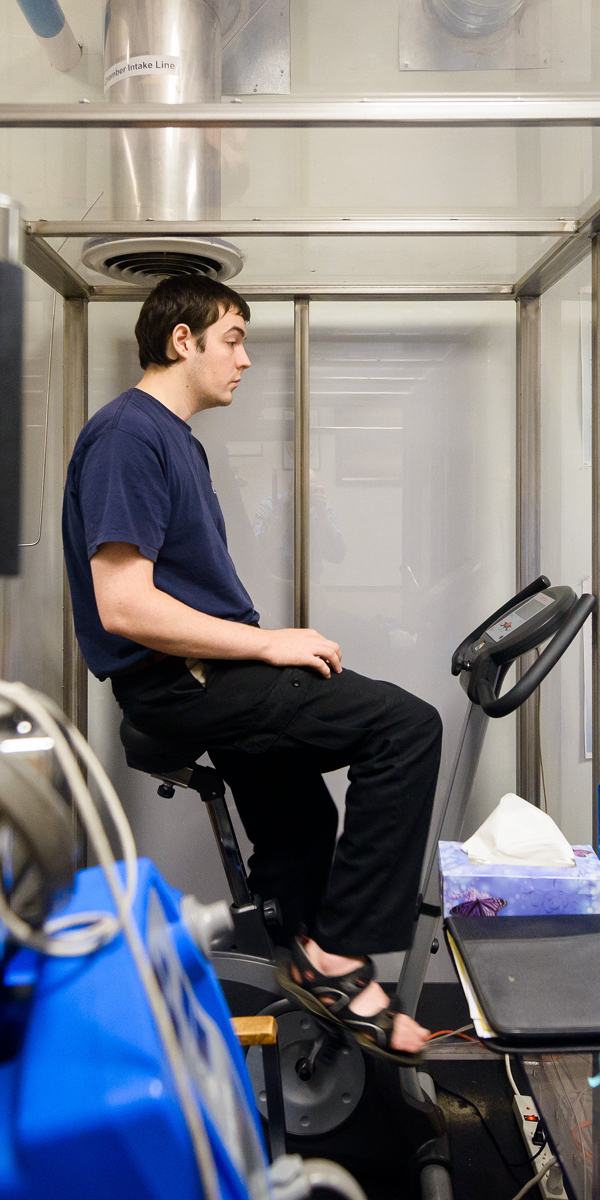 Air pollution can make it hard to breathe. It also can increase someone’s blood pressure and heart rate. Those problems are well known. Now research, in part funded by the BC Lung Association, suggests breathing diesel fumes can trigger another toxic change. It can inappropriately turn some genes on, while turning others off.
Air pollution can make it hard to breathe. It also can increase someone’s blood pressure and heart rate. Those problems are well known. Now research, in part funded by the BC Lung Association, suggests breathing diesel fumes can trigger another toxic change. It can inappropriately turn some genes on, while turning others off.
Just two hours of exposure to diesel exhaust fumes can lead to fundamental health-related changes in biology by switching some genes on, while switching others off, according to researchers at UBC and Vancouver Coastal Health.
The study involved putting volunteers in a polycarbonate-enclosed booth — about the size of a standard bathroom — while breathing in diluted and aged exhaust fumes that are about equal to the air quality along a Beijing highway, or under certain conditions at busy ports, rail yards, mines and industrial sites.
The researchers examined how such exposure affected the chemical “coating” that attaches to many parts of a person’s DNA. That carbon-hydrogen coating, called methylation, can silence or dampen a gene, preventing it from producing a protein – sometimes to a person’s benefit, sometimes not.
The study found that diesel exhaust caused changes in methylation at about 2,800 different points on people’s DNA, affecting about 400 genes. In some places it led to more methylation; in more cases, it decreased methylation.
How these changes in gene expression translate to health is the next step for researchers. But this study shows how vulnerable our genetic machinery can be to air pollution, and that changes are taking place even if there are no obvious symptoms.
“Usually when we look at the effects of air pollution, we measure things that are clinically obvious – air flow, blood pressure, heart rhythm,” said Dr. Chris Carlsten, the study’s senior author and Associate Professor of Respiratory Medicine and Chair In Occupational and Environmental Lung Disease at UBC. “But asthma, higher blood pressure or arrhythmia might just be the gradual accumulation of epigenetic changes. So we’ve revealed a window into how these long-term problems arise. We’re looking at changes ‘deep under the hood.’”
The fact that DNA methylation was affected after only two hours of exposure has positive implications, said Carlsten.
“Any time you can show something happens that quickly, it means you can probably reverse it – either through a therapy, a change in environment, or even diet,” he said.
Carlsten’s team, having catalogued the changes along the entire human genome, is now sharing its data with scientists who are further exploring the function of specific genes.
 Dr. Chris Carlsten is an Associate Professor of Medicine, holds the endowed Chair in Occupational and Environmental Lung Disease at UBC, and is an award-winning researcher. He also holds adjunct positions at the Peter Wall Institute for Advanced Studies, the UBC School of Population and Public Health and the James Hogg Research Centre. As director of the Occupational Lung Disease Clinic at The Lung Centre (Vancouver General Hospital), he welcomes patients with concerns regarding occupational or environmental exposures contributing to respiratory disease including asthma, COPD, interstitial lung disease, cancer, and pleural disease.
Dr. Chris Carlsten is an Associate Professor of Medicine, holds the endowed Chair in Occupational and Environmental Lung Disease at UBC, and is an award-winning researcher. He also holds adjunct positions at the Peter Wall Institute for Advanced Studies, the UBC School of Population and Public Health and the James Hogg Research Centre. As director of the Occupational Lung Disease Clinic at The Lung Centre (Vancouver General Hospital), he welcomes patients with concerns regarding occupational or environmental exposures contributing to respiratory disease including asthma, COPD, interstitial lung disease, cancer, and pleural disease.

